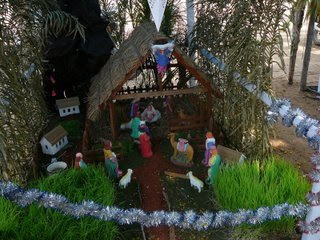Visit the room at Koonammavu, in which Saint Kuriakose Elias Chavara breathed his last
This week I am planning to visit the room at Koonammavu where Saint Kuriakose breathed his last. Will update this post with photos of the visit soon.
Google map
https://www.google.co.in/maps/place/Koonammavu,+Kerala/@10.1099504,76.2592765,14z/data=!3m1!4b1!4m2!3m1!1s0x3b08103a92304429:0xdf60bb50b7cdaf6e?hl=en-GB
About Saint Kuriakose Elias Chavara
Saint Kuriakose Elias Chavara is a Syrian Catholic saint and social reformer from the Indian state of Kerala.He is the second canonised saint of the Syro-Malabar Catholic Church, an Eastern Catholic Church of the Saint Thomas Christian community founded by St. Thomas the Apostle in the first century. He was the co-founder and first Prior General of the first congregation for men in theSyro-Malabar Catholic Church, now known as the Carmelites of Mary Immaculate, and of a similar one for women, the Congregation of the Mother of Carmel.
Google map
https://www.google.co.in/maps/place/Koonammavu,+Kerala/@10.1099504,76.2592765,14z/data=!3m1!4b1!4m2!3m1!1s0x3b08103a92304429:0xdf60bb50b7cdaf6e?hl=en-GB
About Saint Kuriakose Elias Chavara
Saint Kuriakose Elias Chavara is a Syrian Catholic saint and social reformer from the Indian state of Kerala.He is the second canonised saint of the Syro-Malabar Catholic Church, an Eastern Catholic Church of the Saint Thomas Christian community founded by St. Thomas the Apostle in the first century. He was the co-founder and first Prior General of the first congregation for men in theSyro-Malabar Catholic Church, now known as the Carmelites of Mary Immaculate, and of a similar one for women, the Congregation of the Mother of Carmel.
Saint Kuriakose Elias Chavara was born on 10 February 1805 at Kainakary, Kerala in a Nasrani Christian family as the son of Iko (Kuriakose) Chavara and Mariam Thoppil. Nasranis are Saint Thomas Christians (also known as Syrian Chrstians) who are the ancient Christians of Kerala baptized by St. Thomas the Apostle in the first century. The name Kuriakose is derived from the Syriac Aramaic name ܩܘܪܝܩܘܣ (Quriaqos). He was baptized on 17 February 1805 at St. Joseph's Syro-Malabar Church, Chennamkary.
In his childhood, Kuriakose attended the village school. There he studied language and elementary sciences. He entered the seminary in 1818 in Pallipuram where Palackal Thoma Malpan was the Rector. He was ordained a priest on 29 November 1829 and celebrated first Holy Qurbana at St. Joseph's Syro-Malabar Church, Chennamkary.
Fr.Kuriakose joined with two other priests, Palackal Thoma Malpan and Porukara Thoma Kathanar to lead a monastic life. The name of the community they founded was Servants of Mary Immaculate. The foundation for the first Dayra at Mannanam was laid on 11 May 1831 by Porukara Thomas Kathanar. Palackal Malpan and Porukara Kathanar died in 1841 and 1846 respectively. On 8 December 1855, Fr.Kuriakose and ten other priests took vows in the Carmelite tradition. He was nominated as the Prior General of Mannanam Dayra. The congregation became affiliated as a Third Order institute of the Order of Discalced Carmelites. From that point on they used the postnominal initials of T.O.C.D.
Fr.Kuriakose was also a social reformer.Though he hailed from an upper caste Syrian Christian family, he played a major role in educating the people of the lower ranks of society. In 1846, Kuriakose Kathanar St. Joseph's Press at Mannanam which was the third printing press in Kerala and the first press founded by a Malayali without the help of foreigners. From this printing press came the first Malayalam daily Nasrani Deepika. He also started a school at Mannanam in the same year. He was responsible for introducing noon day meals in schools, a practice later adopted by the rulers of Travancore and then by the Indian government. In 1864, while he was serving as the Vicar General of Syrian Catholics, he ordered to start a school along with every church (palli) which was successful in making free education available for everyone. Thus schools in Kerala came to be known as pallikudam.
Fr.Kuriakose introduced retreat preaching for the laity for the first time in the Kerala Church. He popularised devotions and piety exercises such as rosary, way of the cross and eucharistic adoration. He was the Vicar General of Syrian Catholics in 1861 in order to counter the influence of Mar Thomas Rochos on Saint Thomas Christians.
In co-operation with Palackal Thoma Malpan and Thoma Porukara, Kuriakose Kathanar founded an Indian religious congregation for men, now known as the Carmelites of Mary Immaculate. He believed that intellectual development and the education of women was the first step towards overall social welfare. Hence he founded, the Congregation of the Mother of Carmel, the first religious congregation for women in 1866.
Fr.Kuriakose died on 3 January 1871, aged 66, at Koonammavu. His mortal remains were transferred to St. Joseph's Syro-Malabar Dayra Church, Mannanam on 24 May 1889.His memorial is celebrated on 3 January as per the Syro-Malabar liturgical calendar.
Scores of miraculous favours were reported by the intercession of Kuriakose Kathanar. Sister Alphonsa, who later became the first saint of India, has testified in 1936 that Kuriakose Kathanar had appeared to her twice during her illness and relieved her suffering. In 1955, Mar Mathew Kavukattu, arch-bishop of Changanacherry, received instructions from Rome to start diocese-level procedure towards the canonisation. On April 7, 1984, Pope John Paul II approved Kuriakose Kathanar's practice of heroic virtues and declared himVenerable.
Fr.Kuriakose was beatified at Kottayam on 8 February 1986 by Pope John Paul II in the course of a papal visit to India. On 3 April 2014, Pope Francis authorised the Congregation for the Causes of Saints to promulgate the decrees concerning the miracle attributed to Fr.Kuriakose intercession.This confirmed Pope's approval of Fr. Kuriakose's canonisation. On 23 November 2014, he was canonized at Saint Peter's Square by Pope Francis along with Euphrasia Eluvathingal




Comments